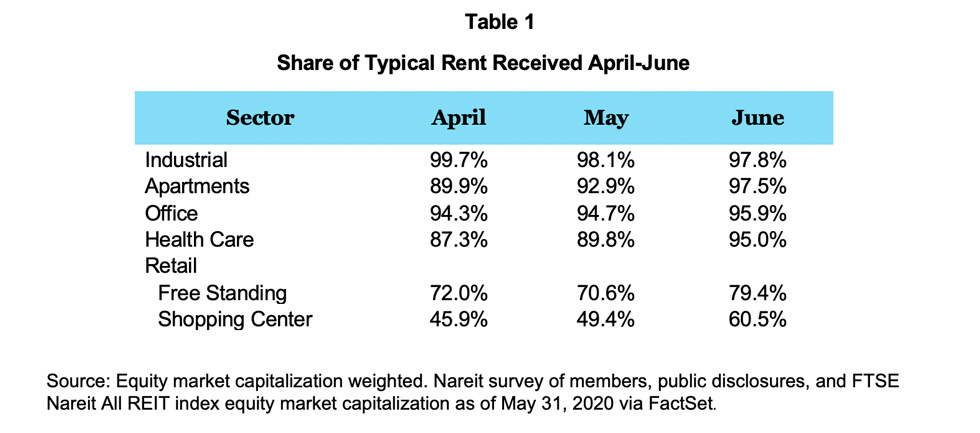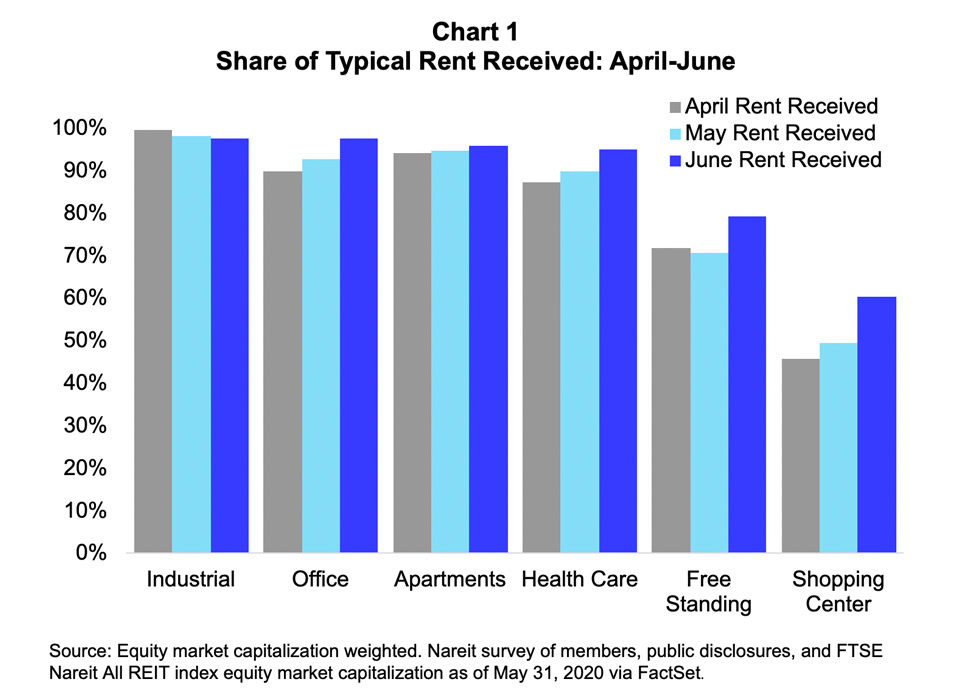June 24, 2020 - Nareit has collected its third month of member surveys about monthly rent collections in the wake of the COVID-19 pandemic and related closures. The June results show an improvement for most sectors compared with last month with large improvements in the retail subsectors for free standing and shopping center-focused REITs, suggesting that re-openings of the retail sector in many parts of the country in May have had a positive economic impact for retail REITs.
Nareit’s survey includes listed equity REITs that combined own and operate between 10% and 20% of commercial real estate in the U.S.
Table 1 shows the estimated REIT rent collections from April to June as a share of typical rent collections. A visualization of the results is in Chart 1. The results are displayed by property sector and are weighted by respondent REIT equity market capitalization.
A total of 35 equity REITs are included in the sample across the six property sectors (industrial, apartments, office, health care, free standing retail, and shopping centers). The sample represents 61% of the FTSE All REITs total equity market capitalization for those property sectors. Sectors are only reported where survey participation is sufficient to maintain participant confidentiality.


Results
- The industrial sector remained the strongest performer with collections equal to nearly 98% of typical rents in June, however industrial REITs show a slight downward trend from April to June. Survey respondents in May and June did not report any forbearance, but did report deferrals of less than 1% of sector rent in both months. Industrial REITs own nearly 4,900 industrial properties in the U.S.
- Apartment collections continued to make gains in June rising to almost 98% of typical rents collected.
- By equity market cap, 80% of apartment REITs in the sample received more or the same share of rent collected in June than May. May survey respondents reported granting rent deferrals for 3% of rent owed, which dropped to 1% for June survey respondents.
- The increased ability of apartment renters to meet their rent obligations reflects the increasing economic activity and the fact that REIT apartments generally serve a population less likely to be affected by layoffs.
- The office sector’s June rent collections experienced a slight increase to 96% from 95% in May. By equity market cap, 82% of office REITs in the sample received more or the same share of rent collected in June than May. June survey respondents reported deferring 1.4% of sector rent owed by equity market cap. There are nearly 1,800 REIT-owned office properties in the U.S.
- The health care sector results reflect a mix of business models, with more than 4,500 senior residential properties and more than 2,800 medical facilities including hospitals and medical office buildings. All REITs in the sample saw an uptick in rents collected for May, and 70% remained the same or saw an increase in June. June’s rent collections surged to 95% from under 90% the previous two months. May survey respondents reported granting rent deferrals for 5% of rent owed while June’s survey respondents reported a slightly lower rate of 4% by equity market cap.
- In the retail sector, there are three sub sectors: shopping centers, regional malls, and free standing retail. Survey participation did not warrant the release of results for malls. The prevalence of essential businesses such as grocery and drug stores among the tenant base for many shopping center and free standing REITs is a stabilizing factor for these types of retail properties.
- There are more than 16,000 REIT-owned free standing retail establishments across the U.S., including big box stores, pharmacies, convenience stores and restaurants. June results for free standing showed a rebound from May’s slightly lower number, with 79% of typical rents paid, up from 71% in May. May and June survey respondents in free standing reported granting rent deferrals for 17% of their May and June rent respectively.
- The U.S. has nearly 2,700 REIT-owned shopping centers. Shopping center REITs saw the biggest increase in rent collected with an 11 percentage point gain in June over May to nearly 61% of typical rent collected. This reflects an increase in rent collected for 67% of shopping center REITs by equity market cap. The sector’s deferral and forbearance rates for June survey respondents show REITs granting deferrals for 9% of rent owed and forbearance for 7%.
Methodology
This research note uses data from Nareit’s April, May, and June rent surveys and publicly disclosed data matched to May’s month-end equity market capitalization. Previous survey results and updates were previously published here and here . Adding public disclosures did not significantly change results and April survey results tracked closely with rent disclosures included in 2020 Q1 earnings.
The results presented in the table and chart are from a matched sample of REITs with valid rent collection data for April, May, and June. The rents for April and May are from either the Nareit surveys or public disclosures. Using a matched sample ensures that changes in results between April and May are not due to the changing composition of the sample. However, readers should note that the matched sample for June is not the same as the matched sample in May—meaning results for April and May have been recalculated for this research note. In general, the results do not differ significantly if we use all the available data for each month or restrict the sample to only Nareit survey respondents. Forbearance and deferral data are calculated for the May and June survey respondents separately.
Several REITs both responded to the surveys and publicly disclosed their April and May rents; the survey data is used in this analysis. The survey asked respondents both the percent of rent collected and the percent of rent typically collected in the same month. In public disclosures, some REITs only disclosed the percent of rent collected. In those cases, we assume typical rent collected is 100%. Some REITs collected more than their typical amount of rent in May. We top coded the share of rent received at 100%.